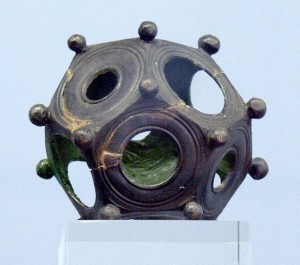Dating from around 200 AD, the Roman dodecahedron is a small hollow object made of bronze or (more rarely) stone, with a geometrical shape that has twelve flat pentagonal faces, each with a circular hole in the middle. All sides connect into a hollowed center.
They were also embellished with a number of knobs at each corner point of the pentagon.
(They are embellished with spheroids at each vertex and circular holes of various diameters in each face)
Ranging from 4 cm to 11 cm, over 100 of these fascinating looking objects have been found in various European parts of the Roman Empire. The focus of findings of the dodecahedrons has been in central modern Europe or today’s France and southwest Germany.
(They were found in multiple locations across the territory of the Roman Empire)
(More than one hundred of these artifacts have been found across Great Britain, Netherlands, Germany, Luxembourg, Austria, Switzerland, France, Belgium and Hungary)
As no classical accounts or narratives seem to mention them, the purpose of this mysterious object remains a puzzling mystery that has confused archaeologists since their first discovery.
In the course of the years, several different theories have been formulated, attempting to clarify the use of the dodecahedron.
(The use or function of the dodecahedra is unknown since there is no mention of them in any text of pictures of that time)
Speculated uses include candlestick holders (wax was found in one of them), flower stands, staff or scepter decorations, a fortune telling devices, a bludgeon, a children’s toy, dice, or a measuring device (more precisely as a range measuring object on the battlefields).
(They appear in various contexts and have been constructed of several materials, such as bronze and stone)
However, the most widely-held theory is that they were religious artifacts, based on the fact that most of the examples have been found in Gallo-Roman sites (one such object was found in a woman’s burial ground).
The Roman dodecahedrons have long been discussed in regards to their actual usage. A satisfactory explanation has yet to be given.
(Roman dodecahedron found in Germany on display in Saalburg castle near Bad Homburg)
(A unique ancient artifact)
In the video below, YouTube user Martin Hallett offers his own thoughts about what the Roman dodecahedrons might have been used for in ancient times.
Ask me anything
Explore related questions













